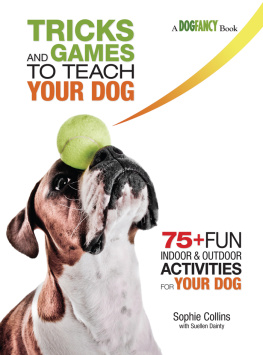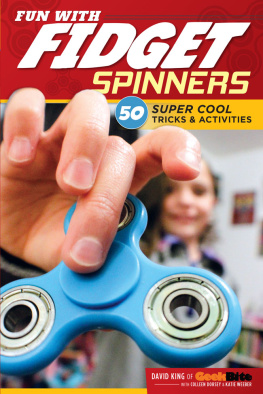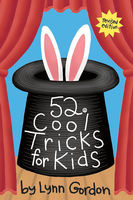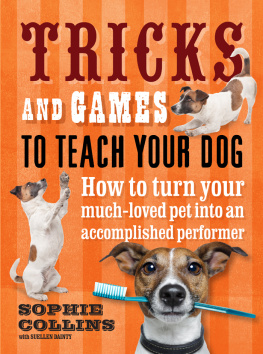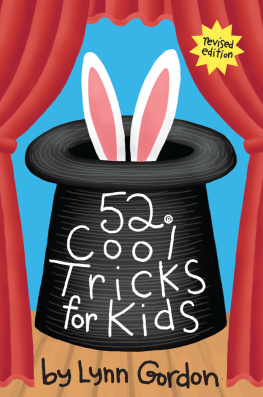
Tricks and Games to Teach Your Dog will open your eyes and your dogs mind to countless canine possibilities. Authors Sophie Collins and Suellen Dainty apply positive-training techniqueslots of tasty treats and upbeat praiseto show you how to teach your dog over 75 fun indoor and outdoor tricks and games.
Beginning with simple tricks, such as shake a paw and rollover, and advancing to more complicated, multi-step tricks that are guaranteed to impress your guests, this abundantly illustrated book is ideal for training dogs of all ages, breeds, and sizes.
Imagine your friends reaction to your genius pup when he shuts a door on cue, passes them the TV remote control, or brings them a tissue when they sneeze! Soon youll be a beaming pet parent when your dog Takes a Bow for his brilliant performance. Cue the applause and let the fun begin!
TRICKS
AND GAMES
TO TEACH
YOUR DOG
75+ FUN INDOOR & OUTDOOR
ACTIVITIES FOR YOUR DOG
SOPHIE COLLINS
with SUELLEN DAINTY

First published in the UK in 2012 by
Ivy Press
210 High Street
Lewes
East Sussex BN7 2NS
United Kingdom
www.ivypress.co.uk
I-5 Press Publication Copyright Ivy Press Limited 2012
All rights reserved. No part of this book may be reproduced or transmitted in any form or by any means, electronic or mechanical, including photocopying, recording, or by any information storage-and-retrieval system, without written permission from the copyright holder.
Library of Congress Cataloging-in-Publication Data
Collins, Sophie.
Tricks and games to teach your dog : 75+ fun indoor & outdoor activities to teach your dog / by Sophie Collins with Suellen Dainty.
pages cm
ISBN 978-1-62187-088-3 (alk. paper)
1. Dogs--Training. 2. Games for dogs. I. Dainty, Suellen. II. Title.
SF431.C626 2014
636.70887--dc23
2013043614
Material in this book first appeared in 50 Games to Play With Your Dog (2008) and 50 Tricks to Teach Your Dog (2011).
This book was conceived, designed and produced by
Ivy Press
Creative Director Peter Bridgewater
Publisher Susan Kelly
Art Director Wayne Blades
Senior Editor Jayne Ansell
Designer Ginny Zeal
Photographer Nick Ridley
Illustrator Joanna Kerr
This book has been published with the intent to provide accurate and authoritative information in regard to the subject matter within. While every reasonable precaution has been taken in preparation of this book, the author and publisher expressly disclaim responsibility for any errors, omissions or adverse effects arising from the use or application of the information contained herein. The techniques and suggestions are used at the readers discretion and are not to be considered a substitute for veterinary care. If you suspect a medical problem, consult your vet.
The author and publisher would like to thank the following for permission to reproduce photographs: A. Inden/zefa/Corbis, (see ).
Contents

Introduction
H ow much does play matter to your dog? If he has good food, plenty of exercise and somewhere comfortable to rest during his downtime, do you really need to play with him, too? Or spend your own downtime teaching him tricks? Well, yes. Why? Theres a whole host of arguments for teaching your pet lots of games and tricks, but here are just a few of them:


Dogs are one of the few specieshumans are one of the othersto enjoy play as adults. There are social, practical reasons for this, as research suggests that dogs use play both to learn things and to get rid of stress. Dogs are cleversome very cleverand, just like people, they need to stretch their minds as well as their bodies to stay healthy and avoid boredom (and remember, a bored, bright dog may well be a dog who gets himself into mischief). As social mammals, dogs need plenty of interaction, too, whether thats with you, their honorary pack leader, or other dogs, and play is one of the most enjoyable ways to interact.
Teaching your pet reinforces your role as his leader and will help to build the bond you already have together. If your dog is used to looking to you for his fun, then it should also be easier for you to catch and deflect his attention when hes thinking about something you dont want him to dowhether its barking at the mail carrier or leaping up over-enthusiastically on an unknown dog.
You can use games both to reinforce trust and to convince your dog that youre his best buddy. If your dog tends to act on his own initiativesometimes a bit more than youd like him tothen having fun with you can also lead him to look more naturally to you for guidance when an unfamiliar situation arises. Independent dogs are often the brightest (and they might be the ones who would manage best if they had to live in the wild), but they can also be the hardest to manage as domestic pets if they arent given clear guidance.
Things to bear in mind: Start and finish every session, whether youre teaching a trick or playing a game, with something your dog is completely familiar with, so you ensure you always begin and end on a good note. If your dog seems slow to pick things up, take your time and keep sessions short: dogs learning rates are very, very variable. Teach little and often, and stay calm and upbeat. Never push your dog too hard; if hes looking frustrated or fed up, youve gone too longand the most important thing of all is that you both have fun!

Keep It Safe
T he tricks and games that follow include some options for every kind of dog: small, large, young, and old. Even if your beloved pet is elderly or hasnt spent much time learning new things, therell still be some simple ideas youll find that you can teach her. Do pay attention to the sidebars on the pagesthey offer safety advice when its necessary and include other useful information and alternative suggestions for different elements for a game or trick to make it suitable for small or large breeds.
Pay attention to your dog when youre teaching active tricks. Usually, if a dog finds it physically uncomfortable to do a trick, shell refuse to try it, so if shes normally eager to earn rewards and attention but is failing to engage with a particular game, it may not be the right one for her. Never assume that your pet is being obstinate if she doesnt appear to want to do something, and never coerce her physically; not only is this ineffective, it may have the very undesirable side effect of making her scared of you or even of playing in general.

Jumping, in particular, should be taught carefully. Puppies shouldnt strain their joints while they are still growing, and elderly dogs who have back problems or who are stiff in the hips shouldnt jump or try any game that involves crawling on their bellies. Stick to some of the more mentally stimulating options if you have a dog who isnt very strong or agile physically.
Next page
